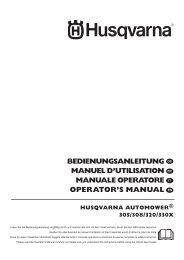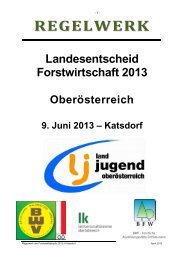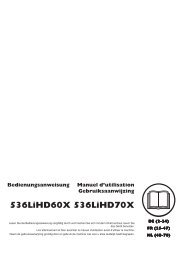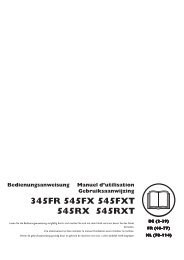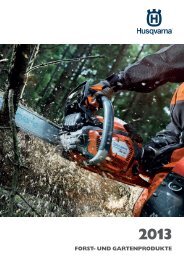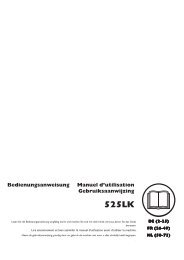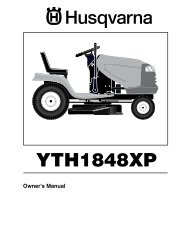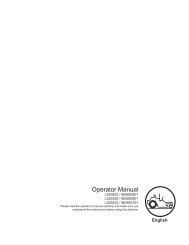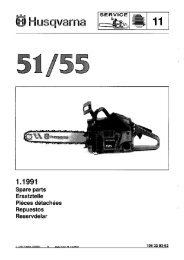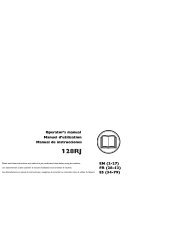OM, T540 XP, 2012-08, EN, FR, ES - Husqvarna
OM, T540 XP, 2012-08, EN, FR, ES - Husqvarna
OM, T540 XP, 2012-08, EN, FR, ES - Husqvarna
You also want an ePaper? Increase the reach of your titles
YUMPU automatically turns print PDFs into web optimized ePapers that Google loves.
WORKING TECHNIQU<strong>ES</strong><br />
6 If you have to cut branches or the like that are above<br />
shoulder height, a working platform or scaffold tower<br />
is recommended.<br />
7 Take great care when you cut with the top edge of the<br />
bar, i.e. when cutting from the underside of the object.<br />
This is known as cutting with a pushing chain. The<br />
chain tries to push the chain saw back towards the<br />
user. If the saw chain is jamming, the saw may be<br />
pushed back at you.<br />
Working with tree service chain-saws<br />
from a rope and harness<br />
This chapter sets out working practices to reduce the risk<br />
of injury from tree service chainsaws when working at<br />
height from a rope and harness. While it may form the<br />
basis of guidance and training literature, it should not be<br />
regarded as a substitute for formal training.<br />
General requirements working at height<br />
Operators of tree service chainsaws working at height<br />
from a rope and harness should never work alone. A<br />
competent ground worker trained in appropriate<br />
emergency procedures should assist them.<br />
Operators of tree service chainsaws for this work should<br />
be trained in general safe climbing and work positioning<br />
techniques and shall properly equipped with harnesses,<br />
ropes, strops, karabiners and other equipment for<br />
maintaining secure and safe working positions for both<br />
themselves and the saw.<br />
Preparing to use the saw in the tree<br />
The chain saw should be checked, fuelled, started and<br />
warmed up by the ground worker and the chain brake<br />
should be engaged before it is sent up to the operator in<br />
the tree. The chainsaw should be fitted with a suitable<br />
strop for attaching to the operator’s harness:<br />
a) attach the rope around the rope eyelet on the rear of the<br />
saw.<br />
8 Unless the user resists this pushing force there is a<br />
risk that the chain saw will move so far backwards that<br />
only the kickback zone of the bar is in contact with the<br />
tree, which can lead to a kickback.<br />
Cutting with the bottom edge of the bar, i.e. from the<br />
top of the object downwards, is known as cutting with<br />
a pulling chain. In this case the chain saw pulls itself<br />
towards the tree and the front edge of the chain saw<br />
body rests naturally on the trunk when cutting. Cutting<br />
with a pulling chain gives the operator better control<br />
over the chain saw and the position of the kickback<br />
zone.<br />
9 Follow the instructions on sharpening and maintaining<br />
your bar and chain. When you replace the bar and<br />
chain use only combinations that are recommended<br />
by us. See instructions under the headings Cutting<br />
equipment and Technical data.<br />
26 – English<br />
b) provide suitable karabiners to allow indirect (i.e. via the<br />
strop) and direct attachment (i.e. at the attachment point<br />
on the saw) of saw to the operators harness.<br />
CAUTION! The belt eyelet is not dimensioned for use with<br />
a so-called safety rope. Use the rope eyelet for this<br />
purpose.<br />
c) ensure the saw is securely attached when it is being<br />
sent up to the operator.<br />
d) ensure the saw is secured to the harness before it is<br />
disconnected from the means of ascent.<br />
The saw should only be attached to the recommended<br />
attachment points on the harness. These may be at midpoint<br />
(front or rear) or at the sides. Where possible<br />
attaching the saw to centre rear mid-point will keep it clear<br />
of climbing lines and support its weight centrally down the<br />
operator’s spine.



